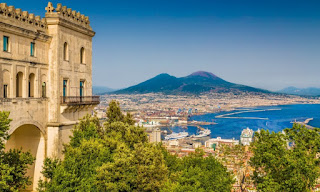Naples was the fag
end of my journey after 10 days of traipsing across Florence, Venice and Rome
with a college buddy. And this was one place where I was cautioned about being
mugged or robbed; petty crime being a way of life in Italy. But Naples took my
breath away, despite holding on to my backpack (which I wore on my front) on to
dear life.
Think Italy and you
picture the canals of Venice, the imperialistic Rome, the holy Vatican, the
There’s so much to
see and do in and around Naples; you could spend an entire week here and still
not do it all. Be it churches, museums, parks, palaces, lakes; or strolling
around the ancient city of Pompeii, climbing the Vesuvius volcano or taking a
ferry to visit the chic island of Capri.
But what’s most
fascinating is not what you see around Naples, it’s what’s deep below the city
– an entire another city.
As you descend 40
metres deep below the surface under layers and layers of volcanic earth, one
goes down in time, almost 2400 years. Here you find a different world,
unexplored, isolated by time, but deeply connected with the world above – the
underground city of ancient Naples.
Excavations deep below the surface over the
years have unearthed labyrinths of ancient Greco Roman times dating back to
almost the 1st century. This
hidden city beneath today’s city of Naples can be accessed from different
places around the city. Some reveal ancient water aqueducts and sewer systems
dating back 23 centuries; some lead to ancient dwellings with pottery shards
that probably indicate a communal kitchen. One that is accessed through a trap
door on the floor of current house on street level, apparently was the place
where Nero famously played the fiddle during theatre performances.
The one I visited was
a Greco-Roman ruin beneath the 18th-century cloister at San Lorenzo Maggiore.
Descending a carefully constructed wooden staircase and almost 40 meters below
street level, I found myself time travelling to an era centuries behind the
present time. Entire streets and houses have been unearthed here and I found myself
wandering and peering into the lives of a first-century A.D. Roman market, a
barrel-vaulted shopping arcade, a domed oven of an ancient bakery and a
communal laundry complete with tubs and drains.
The catacombs present
a surreal synchronicity of eerie silence together with an almost cacophonic
jumble of visual imageries – of ancient caves and Roman markets, early
Christian burial sites of faded frescoes and colourful mosaics, layered with
World War II air-raid shelters, which some of these spaces were later converted to.
Surreal, compelling
and utterly fascinating! It’s one thing to visit museums and see carefully
preserved artefacts from ancient times behind thick glass enclosures, but to
walk along what was once the street s of the bygone era and among the carefully
unearthed and beautifully preserved lives of ancient civilisation is an
experience that just cannot be missed.






